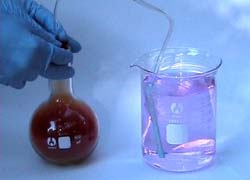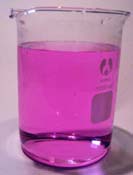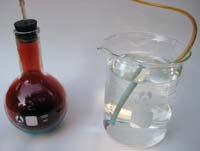Nitric Acid
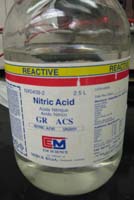 Nitric
acid (HNO3) is a very strong monoprotic acid which
has the ability to dissolve metals, and other substances,
which are usually inert to ordinary acids. Nitric acid is an
incredibly useful chemical for use in production of nitrate
salts and etching metals due to its strongly oxidizing and
corrosive nature.
Nitric
acid (HNO3) is a very strong monoprotic acid which
has the ability to dissolve metals, and other substances,
which are usually inert to ordinary acids. Nitric acid is an
incredibly useful chemical for use in production of nitrate
salts and etching metals due to its strongly oxidizing and
corrosive nature.
Concentrated Nitric acid (>86% HNO3 by weight) is sometimes referred to as "fuming" Nitric acid as it will emit considerable amounts of fumes at such high concentrations. At elevated temperatures and when exposed to intense light sources Nitric acid will decompose into Nitrogen Oxide (NO, NO2) gasses. These NOx gasses can dissolve in the aqueous acid solution and impart a light brown to red color in the otherwise clear acid. For this reason, concentrated HNO3 solutions are also sometimes given a colorful prefix ("white" or "red") depending on the presence of the dissolved Nitrogen Oxides.

Due to its highly corrosive nature and potential oxidizing properties, Nitric acid can be extremely dangerous when not handled responsibly. Always wear proper protective clothing when working around Nitric Acid (including, but not limited to, gloves and eye protection), and practice appropriate safety precautions.
Nitric acid can cause sever burns and discoloration if it should come into contact with one’s skin. Gloves and eye protection are particularly important when working around Nitric acid. Only work with Nitric acid in a ventilated area and have access to appropriate spill clean-up and neutralization supplies. Do not inhale fumes.
Oxidizing Properties
The oxidizing nature of Nitric acid is evident in its reaction with Copper, a metal which is inert to most ordinary acids. Nitric acid will dissolve Copper metal, producing Copper Nitrate, water, and Nitrogen Oxide gas, NOx (NO or NO2 depending on acid concentration). The reaction between Copper metal and concentrated Nitric acid is shown below,
![]()
|
Video
|
|---|
Above: Nitric acid reacts with Copper coins inside a flask. After the Nitric acid is added, the flask quickly fills with dark Nitrogen Dioxide (NO2) gas. A hose is attached to the flask to bubble the NO2 gas through a Sodium Hydroxide solution inside the beaker on the right. Although it is difficult to see in the video, the NaOH solution in the beaker starts out a dark-pink / purple color due to the presence of Phenolphthalein, a pH indicator for alkaline solutions. As the NO2 gas bubbles through the NaOH solution some of the gas dissolves, thus causing the pH to drop and the color of the solution to turn clear (occurs when pH < 8.2); for a better view of the color change see the before and after pictures below.
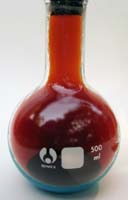
Above: Flask filled
with Nitrogen Dioxide gas
Last updated:
05/21/2008



